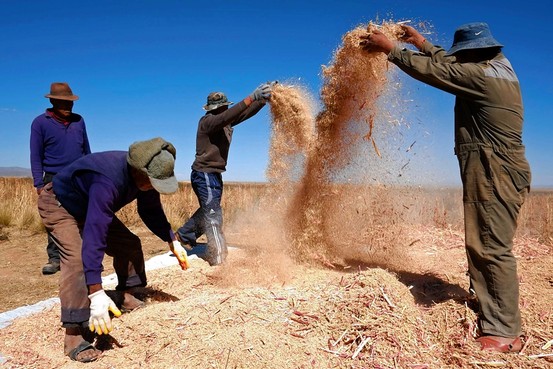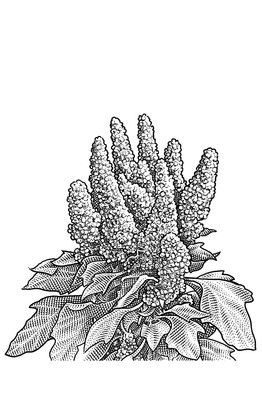
(above) Farmers separate grains during a quinoa harvest in Bolivia. The Andean staple is now popular in the U.S. Credit: Reuters
Quinoa Faces a Backlash
September 13, 2013 - Wall Street Journal
Quinoa, long obscure in the U.S., has become a favorite of foodies. Now some people dare to say they hate it
By MIRIAM JORDAN
Everywhere Jessica Hardy turned, it seemed as if someone was telling her to eat quinoa. The message, she recalls, seemed to be: "If you just eat quinoa for the rest of your life, you'll die happy."
After visiting yet another restaurant where quinoa appeared on the menu in "five different forms," she says, the Vancouver writer last year decided she'd had enough of "people's blind devotion" to the bead-size food. She banged out a piece for a local news website, called "Five Reasons to Hate Quinoa."
The quinoa crowd squawked. "Oh come on, how can anyone hate quinoa?" read one comment.
"It's not like I had insulted their mother," says Ms. Hardy, 34 years old. "It's just a grain."
Ms. Hardy was a trailblazer in the budding anti-quinoa movement: people daring to deride the superfood on blogs and social-networking sites—if not yet to their friends' faces.
"I'm just going to come right out and say it," began Janelle Rouse of Iowa on Twitter last month. "I don't actually like quinoa."
She wasn't the only one eager to get her true feelings about quinoa off her chest. A "Dickensian gruel" is how another Twitter user described it. Someone else likened the translucent grains to "itty-bitty tadpoles that twitch around in ponds."
(below) Quinoa
Grown in the Andes for thousands of years, the "mother grain of the Incas" was an obscurity in the U.S. until it was discovered by foodies who feted it as a superior alternative to bulgur wheat, couscous and rice. Though it often occupies a similar role to these grains, quinoa is actually a chenopod, in the same family as beets and chard.
Quinoa (pronounced KEEN-wah), whose edible seeds are white, red or black, is packed with protein, minerals and vitamins. It's gluten-free. You can have it for breakfast (as a cereal), lunch (as a salad) and dinner (in a pattie or as a side).
"It wasn't there, and then it was everywhere," is how Jonathan Milder, who tracks food trends for the Food Network, sums it up. A few years ago, he adds, "most people didn't know of quinoa's existence, hadn't heard the word."
Then cookbooks like "Quinoa 365: The Everyday Superfood" began to spring up in bookstores. Dr. Oz recommended a quinoa-with-prunes concoction to "reboot your body." Debate, still unresolved, erupted over whether quinoa is kosher for Passover.
Production of quinoa spiked and its price soared on the world market.
The United Nations designated 2013 the "International Year of Quinoa." At the February launch, Secretary-General Ban Ki-moon deemed the crop "extraordinary." Bolivian President Evo Morales championed indigenous people's role as custodians of the crop.
John Breitfelder, 9 years old, won first lady Michelle Obama's 2013 Healthy Lunchtime Challenge for Connecticut with his "quinoa risotto with shrimp and kale" recipe. That earned him attendance at a state dinner with Mrs. Obama. The New Canaan public school district served it as the hot-lunch item on Sept. 12.
What's not to like about quinoa? Its bland taste, gravely texture, tongue-twister name and fanatical fan base, detractors say.
"There's a certain undeliciousness to the stuff," says Mr. Milder of the Food Network. "It's the unspeakable truth about the quinoa. Basically, you're eating a beet in grain form."
For quinoa to become agreeable, he says, it must be met with superior force, such as chili.
In a new Bud Light ad, a football fan declares that quinoa tastes like a "dirty old tree branch," but decides to eat it anyway because his team won the last time it was packed for him and he "accidentally" ate it.
Lilliane Coldwell of Atlanta bet on quinoa to help her lose weight. She tested savory and sweet recipes, and drowned quinoa in vanilla and blueberries—all to no avail. "It was awful. There is literally no taste to it," says the grocery clerk, who decided it was a "chore" to chew.
Her quinoa-aficionado friends haven't let up the pressure. They keep insisting she must have cooked or washed her quinoa improperly. "I'll have you over for my quinoa," she says they tell her.
Quinoa's popularity could be a boon to the toothpick industry, predicts Mr. Milder. The cooked seeds don't bond together, so they tend to settle individually between teeth and in other crevices in the mouth.
"There is really nothing more unpleasant" than quinoa's tendency "to get stuck between gum and cheek," says Jan Greco, a food blogger in New Jersey.
Last month, she mustered the courage to tweet that she had a "confession to make…I HATE quinoa!"
"I think there are a lot of us out there. But to say you hate it, you're the devil," says Ms. Greco.
Sociologist Sharon Zukin figures many of those averse to quinoa are "stomach libertarians" at heart, protesting the tyranny of the food police.
In Kuwait, Shaza Ayesh, 24, says she encounters too many "ridiculously rich people" who eat quinoa "just to say they ate quinoa." She says some well-intended friends enamored of quinoa's health halo try to sneak "that sand gravel" onto her plate.
"I don't stay up late at night plotting the destruction of the quinoa industry," Ms. Ayesh says. But fed up with the fuss, she took to her blog and wrote: "Screw You, Quinoa."
How to pronounce quinoa poses another conundrum.
"Even if you fancy yourself a trendsetter, don't lie to me: you know you pronounced it 'quin-oh-ah' the first time you saw it," Ms. Hardy wrote in her piece.
Next to a picture of white quinoa and a picture of open pouches of silica gel, she wrote, that the food looks like it will guard your "leather boots from moisture."
Then there are people concerned the quinoa craze could turn into a quinoa curse for Andean farmers.
"I could see them exporting all their quinoa and eating McDonald's," says Alexander Dita, a Web developer in Sacramento, Calif., who has taken his trepidation to Twitter.
Quinoa could prove to have no more staying power than previous food fads. After reaching 7,912 tons in 2011, more than 10 times the 2007 volume, U.S. imports of quinoa slipped to 5,268 tons last year, according to Datamyne, a provider of data on global trade.
"The quinoa craze may be leveling off," says Lisa Wallerstein, Datamyne's marketing vice president.
At GreenStar Cooperative Market in Ithaca, N.Y., manager Brandon Kane doesn't buy that. The natural-food retailer says demand is as strong as ever for quinoa, sold in bulk, prepackaged and in items such as bread, bars and veggie burgers. If anything, he reckons "quinoa is going mainstream."
If that is the new normal, "I don't like quinoa. Call me a 2013 rebel," said one recent tweet.
Write to Miriam Jordan at miriam.jordan@wsj.com